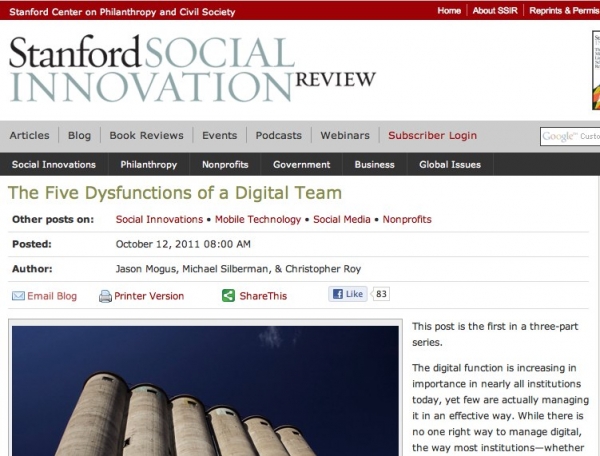This is the first in a three part series on digital team structures published in the Stanford Social Innovation Review.
The digital function is increasing in importance in nearly all institutions today, yet few are actually managing it in an effective way. While there is no one right way to manage digital, the way most institutions—whether corporate, government, or nonprofit—structure their digital teams greatly limits the outcomes they seek, because every innovation they want to do online will be limited by their own internal capacity to dream, execute, and sustain it over time.
When an organization’s external digital presence is inconsistent or incoherent, this is nearly always a symptom of deeper internal structural problems, such as:
- Silos: The people responsible for digital work are isolated from the rest of the organization, and the team ends up becoming a quick-turn-around “Kinkos copy shop” for publishing. The digital lead may not be seated at a high enough level to be proactive, or it may have a director who does not represent digital well for leadership or cross-team planning opportunities.
- Personality Fit: You have the wrong person in the digital role. Digital work interfaces with all aspects of an organization, so the person responsible must be open-minded, solutions-oriented, and ideally a delight to work with.
- Overload: Often the digital team isn’t the right size to keep up with increasing demands, or the leader is unable to prioritize the volume of work on their own. Often they don’t know how to say no to requests that are unrealistic or that don’t fit their vision.
- Lack of Digital Vision: Every organization needs a digital vision to set a direction and evaluate whether the inevitable new tools, creative ideas, and campaigns requested are actually viabile online ideas and fit the strategy.
- Lack of Organizational Vision: A good digital communications strategy can’t compensate for a missing organizational vision or outdated theory of change, both of which have to come first. If you can’t clearly articulate what your organization is trying to change in the world and how your supporters can play a meaningful role in it, then you’re just asking your digital team to create pseudo engagement with often increasingly meaningless actions.
You can read the full post at the Stanford Social Innovation Review website. The article was co-written by myself, my senior strategy colleague at Communicopia Christopher Roy, and Michael Silberman who runs the new Global Digital Innovation Lab at Greenpeace.
Part two reviews the Four Models for Organizing Digital Work at your organization.

Jason Mogus is Communicopia’s principal consultant and is the founder of Web of Change. He has been developing digital strategies for social change organizations for over 15 years. You can follow him at @mogusmoves.









